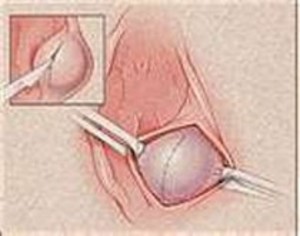When healthcare professionals discuss sexually transmitted diseases with their female patients, they seldom mention a Bartholin’s abscess. However, this painful condition is extremely common in women of childbearing age and can cause significant pain and swelling if not treated in its early stages. The condition is easily diagnosed and treated and usually can be prevented by following medical advice.
A Bartholin’s abscess forms in the Bartholin’s gland,a small pea sized gland located under the skin on each side if the vagina. Bartholin’s glands secrete fluid that keeps the vagina lubricated. Most women never know they have Bartholin’s glands until there is a problem. In some women, Bartholin’s glands can become blocked, causing fluid build up. The result is a Bartholin’s Cyst. These cysts are very common, especially in menstruating women. They are seldom painful unless they grow to become very large. If bacteria enter the cyst, an infection can occur. An infected cyst is called an abscess.
Bartholin’s abscesses and cysts are diagnosed by visual examination. Additional tests are usually not required, but in the case of abscesses, the fluid may be aspirated and sent to a lab for bacterial identification. A cyst is hard round bulge, ranging in size from ¼ inch to as large as three inches, on the vaginal lips. Cysts are usually on one side of the vagina, but in rare cases may occur on both sides. It may be painless or slightly tender, but should not be extremely painful.
A Bartholin’s abscess will be very red, swollen and painful. It may be difficult to sit or walk because of the intense pain. Some abscesses are caused by bacteria present on the skin, but others are caused by sexually transmitted bacteria. A warm sitz bath is used for treating cysts and small abscesses, and abscesses will often burst and drain on their own after three or four days. If the abscess is large or extremely painful, additional treatment by a doctor is necessary. Larger cysts and abscesses are often treated by making a small incision in the cyst or abscess to allow the fluid to drain. The cyst is them stitched closed, with a small opening left for continued drainage. For recurrent cysts, the gland may be removed.
In many cases, Bartholin’s Cysts and abscesses can not be prevented, but if you have experienced recurrent problems, you can reduce the number if recurrences by using condoms. If cysts recur during your menstrual period, be sure to thoroughly wash you hands before inserting a tampon.


